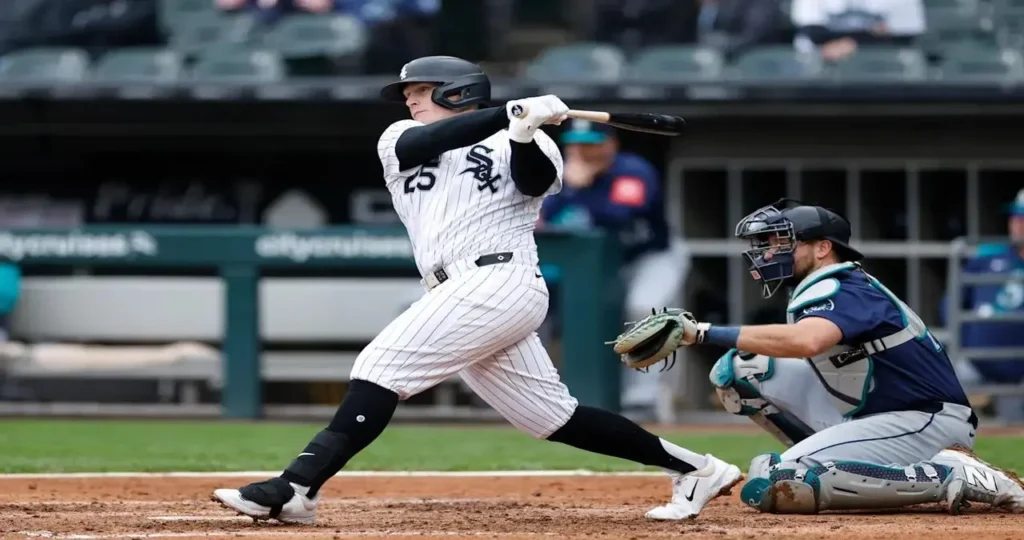Andrew Vaughn Fangraphsz: When it comes to modern baseball, stats are no longer just about batting average or RBIs. They’re about deeper metrics, advanced analysis, and predictive projections something Fangraphs has perfected over the years. One name that continually sparks attention on the platform is Andrew Vaughn. His journey from a top collegiate bat to a major league mainstay has been thoroughly tracked by Fangraphs, making “Andrew Vaughn Fangraphs” a hot keyword for fans, analysts, and fantasy baseball gurus alike. Let’s explore what makes Vaughn a fascinating player through the lens of Fangraphs’ data, projections, and scouting tools.
Understanding Andrew Vaughn Through the Fangraphs Lens
Andrew Vaughn was never just another prospect. From his collegiate days at Cal to his professional debut with the Chicago White Sox, Vaughn has always attracted attention. Fangraphs, known for their detailed player profiles, scouting reports, and advanced metrics, has documented every stage of Vaughn’s development.
Fangraphs showcases Vaughn’s offensive profile in rich detail, giving fans a look at more than just his batting average. With metrics like wRC+, BABIP, ISO, and plate discipline stats, we begin to see what separates Vaughn from your typical slugger. His consistent hard-hit rates, low chase percentages, and evolving contact ability show the journey of a hitter refining his craft against the best pitchers in the world.
On Fangraphs, Vaughn’s player page is a treasure trove for stat-savvy readers. You’ll find seasonal splits, advanced batted-ball data, spray charts, and rolling graphs that track his performance trends. These details matter when evaluating how well a player like Vaughn adjusts throughout the season, especially considering his transition from college to the majors without much minor league seasoning.
Fangraphs Scouting and Prospect Grades: Where Vaughn Stood
Before Andrew Vaughn made it to the bigs, Fangraphs had already evaluated him as one of the premier hitting prospects in baseball. Their prospect rankings placed Vaughn near the top, not just in the White Sox system but across the league. His Future Value (FV) grades and scouting grades were notably high, particularly in the hit and power tools.
What made Vaughn such an attractive prospect on Fangraphs was the completeness of his offensive game. He wasn’t just a one-dimensional power bat. His college stats were absurdly good, and his approach at the plate was considered “major league ready” even before he swung a bat in pro ball. Fangraphs scouts loved his balance, quick hands, and discipline, making note of how rare it is to see such a refined hitter at that stage of development.
Fangraphs’ in-depth analysis didn’t stop at raw numbers either. Their prospect write-ups included granular observations on his stance, swing path, timing mechanism, and even his defensive capabilities at first base. Although his glove was seen as average at best, Vaughn’s bat was so potent that teams (and Fangraphs analysts) were willing to overlook any defensive shortcomings.
Andrew Vaughn’s Offensive Performance by the Numbers
Diving deeper into Vaughn’s Fangraphs page today reveals a complex picture. He’s no longer just a prospect; he’s now being evaluated against major league talent. This means every swing, miss, walk, and homer is magnified and tracked in detail.
One of the key metrics used to evaluate Vaughn on Fangraphs is wRC+ (Weighted Runs Created Plus). This stat gives context to a player’s offensive contributions by adjusting for ballpark and league factors. Vaughn’s wRC+ has hovered around league average during his early MLB seasons, but context is key. Given his lack of minor league reps and being thrown into various defensive roles, he’s done remarkably well under the circumstances.
His plate discipline numbers O-Swing%, Z-Contact%, and BB% show that Vaughn has maintained the patient approach that made him successful in college. Fangraphs also tracks swinging-strike rates, and Vaughn’s numbers here are better than average for a power hitter, highlighting his rare ability to combine power with contact.
The Role of Position Flexibility in Vaughn’s Value
Fangraphs isn’t just about offensive stats. They also evaluate defense, baserunning, and positional adjustments. For Vaughn, this has been a double-edged sword. While his bat was MLB-ready, the White Sox moved him around the diamond left field, right field, and even some first base reps.
Fangraphs’ positional adjustment metrics (used in calculating WAR) show how these changes affect a player’s overall value. Vaughn’s outfield defense, graded through metrics like UZR (Ultimate Zone Rating) and DRS (Defensive Runs Saved), hasn’t been stellar. These negative ratings lower his WAR totals, which can sometimes skew the perception of his overall value.
However, context matters. Vaughn wasn’t drafted to play the outfield, and Fangraphs often points out how out-of-position roles can mask a player’s true talent. Their writing team frequently comments on how Vaughn’s bat-first profile remains intriguing, even if his defensive metrics drag down his WAR a bit. This is where Fangraphs shines providing readers with both the raw data and the narrative analysis needed to interpret it.
How Vaughn’s Fangraphs Projections Shape Expectations
Fangraphs provides various projection systems such as ZiPS, Steamer, and THE BAT X. These systems are staples for fantasy players and analysts, giving expected stats based on historical trends, player comps, and aging curves. For Andrew Vaughn, these projections have been cautiously optimistic.
ZiPS has long projected Vaughn as a solid middle-of-the-order bat with a high OBP floor and solid slugging potential. While he hasn’t yet broken out into superstardom, his underlying metrics suggest that a breakout season isn’t far off. Steamer, another projection model on Fangraphs, has also consistently pegged Vaughn for steady improvement year over year.
What makes Fangraphs’ projections powerful is their flexibility. As Vaughn accumulates more plate appearances and Statcast data, these systems adjust. And with every uptick in launch angle or hard-hit percentage, Fangraphs’ models subtly nudge Vaughn’s forecasted line upward, giving us a real-time glimpse into his evolving potential.
Fangraphs’ Editorial Insight on Vaughn’s Development
Beyond numbers, Fangraphs offers editorial takes that enrich their analysis. Their writers dive into swing mechanics, team strategy, player development, and coaching areas that often explain why a player is or isn’t succeeding. Andrew Vaughn is a frequent subject in such articles, often tied to discussions about the White Sox’s organizational strategy.
For instance, Fangraphs analysts have debated whether the White Sox did Vaughn any favors by rushing him to the majors or bouncing him around defensively. Some writers argue that his development would have been smoother if he had been given consistent at-bats at his natural position. Others suggest his handling of these challenges shows mental toughness and a solid foundation.
Their coverage of Vaughn tends to be fair and balanced, acknowledging both his promise and his struggles. You’ll find breakdowns on his swing decisions, comparisons to historical comps, and discussions about his future ceiling. That’s what makes searching “Andrew Vaughn Fangraphs” so rewarding you get more than just numbers; you get a full context story.

Comparing Vaughn to Peers Using Fangraphs Tools
Fangraphs doesn’t just evaluate players in isolation. Their leaderboards, stat filters, and interactive charts allow readers to compare players across a range of metrics. Want to know how Vaughn stacks up against other young corner infielders or power hitters with low strikeout rates? Fangraphs makes that easy.
Using tools like the custom leaderboard, you can filter by age, position, plate appearances, and more to create meaningful comparisons. Vaughn holds his own in several categories, especially when it comes to hard-hit rate, contact percentage, and walk rate. He may not yet be a household name like Vladimir Guerrero Jr., but his numbers indicate he’s not far off from that tier.
This kind of comparative analysis helps put Vaughn’s journey in perspective. It also highlights how Fangraphs serves not just as a stat archive but as an interpretive platform for evaluating performance in the broader MLB ecosystem.
Future Value and the Ongoing Fangraphs Conversation
The term “Future Value,” or FV, is central to Fangraphs’ prospect evaluations. Vaughn’s FV when he entered the league was among the highest for first base prospects, reflecting his elite hit tool and projectable power. But FV isn’t static it evolves based on performance, health, opportunity, and team context.
Vaughn’s FV has fluctuated slightly in the minds of analysts, but his core skill set keeps him relevant in Fangraphs’ conversation. He remains a player who could blossom into a perennial All-Star or settle in as a reliable middle-of-the-order bat. Either outcome is valuable, especially when measured by WAR and advanced metrics that account for more than just counting stats.
Fangraphs also explores broader themes, like how the shift ban or evolving pitcher usage trends could impact players like Vaughn. With defenses playing more straight-up, Vaughn’s ability to use the entire field could boost his average and slugging, and Fangraphs analysts are already speculating on how these league-wide changes may affect his profile moving forward.
Closing Thoughts on Andrew Vaughn Fangraphs Coverage
So what does all this mean? The keyword “Andrew Vaughn Fangraphs” opens up a world of nuanced data, expert commentary, and actionable insight for fans, scouts, and fantasy managers alike. Whether you’re digging into his batted-ball profile, exploring his future through ZiPS projections, or simply comparing him to his peers, Fangraphs offers everything you need to track Vaughn’s journey.
Andrew Vaughn is not a finished product. But through the lens of Fangraphs, we see the making of a player with the tools, mindset, and data-backed potential to become a cornerstone for the White Sox. The stats speak volumes, but so does the analytical depth Fangraphs brings to the conversation. For those invested in his future, there’s no better place to follow the narrative than right there on his Fangraphs page.



